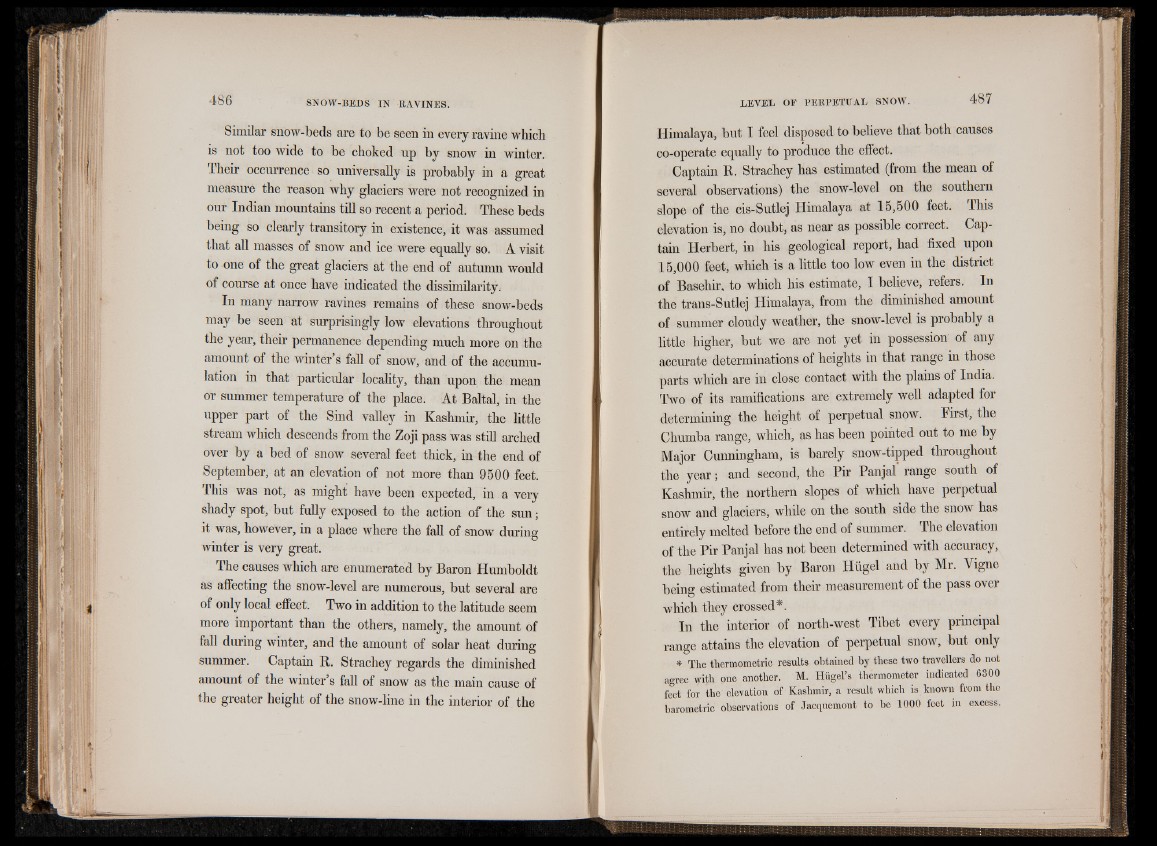
Similar snow-beds are to be seen in every ravine which
is not too wide to be choked up by snow in winter.
Their occurrence so universally is probably in a great
measure the reason why glaciers were not recognized in
our Indian mountains till so recent a period. These beds
being so clearly transitory in existence, it was assumed
that all masses of snow and ice were equally so. A visit
to one of the great glaciers at the end of autumn would
of course at once have indicated the dissimilarity.
In many narrow ravines remains of these snow-beds
may be seen at surprisingly low elevations throughout
the year, their permanence depending much more on the
amount of the winter’s fall of snow, and of the accumulation
in that particular locality, than upon the mean
or summer temperature of the place. At Baltal, in the
upper part of the Sind valley in Kashmir, the little
stream which descends from the Zoji pass was still arched
over by a bed of snow several feet thick, in the end of
September, at an elevation of not more than 9500 feet.
This was not, as might have been expected, in a very
shady spot, but fully exposed to the action of the sun •
it was, however, in a place where the fall of snow during
winter is very great.
The causes which are enumerated by Baron Humboldt
as affecting the snow-level are numerous, but several are
of only local effect. Two in addition to the latitude seem
more important than the others, namely, the amount of
fall during winter, and the amount of solar heat during
summer. Captain R. Strachey regards the diminished
amount of the winter’s fall of snow as the main cause of
the greater height of the snow-line in the interior of the
Himalaya, but I feel disposed to believe that both causes
co-operate equally to produce the effect.
Captain R. Strachey has estimated (from the mean of
several observations) the snow-level on the southern
slope of the cis-Sutlej Himalaya at 15,500 feet. This
elevation is, no doubt, as near as possible correct. Captain
Herbert, in his geological report, had fixed upon
15,000 feet, which is a little too low even in the district
of Basehir, to which his estimate, I believe, refers. In
the trans-Sutlej Himalaya, from the diminished amount
of summer cloudy weather, the snow-level is probably a
little higher, but we are not yet in possession of any
accurate determinations of heights in that range in those
parts which are in close contact with the plains of India.
Two of its ramifications are extremely well adapted for
determining the height of perpetual snow. Pirst, the
Chumba range, which, as has been pointed out to me by
Major Cunningham, is barely snow-tipped throughout
the year; and second, the Pir Panjal range south of
Kashmir, the northern slopes of which have perpetual
snow and glaciers, while on the south side the snow has
entirely melted before the end of summer. The elevation
of the Pir Panjal has not been determined with accuracy,
the heights given by Baron Hiigel and by Mr. Yigne
being estimated from their measurement of the pass over
which they crossed*.
In the interior of north-west Tibet every principal
range attains the elevation of perpetual snow, but only
* The thermometric results obtained by these two travellers do not
agree with one another. M. Hugel’s thermometer indicated 6300
feet for the elevation of Kashmir, a result which is known from the
barometric observations of Jacquemont to be 1000 feet in excess.